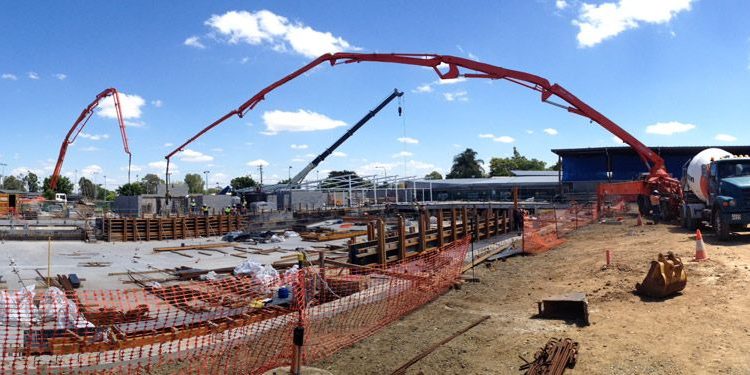The pumping of concrete has become one of the fastest growing methods of trans- porting and handling at the job site. Pumping is a point-to- point delivery system in which con- crete is moved under pressure through
rigid pipe, flexible hose or a combina- tion ofboth to its final destination in the forms with little ne- cessity for further handling of the mix. Hence, with pumping there is less chance for segregation.
There are a number of other advantages in pumping concrete that should be con- sidered when evaluat-ing job site transport-ing and handling methods. The use of pumps can eliminate or greatly reduce the need for access roads, scaffolding, and other concrete handling equipment. Hoists and cranes are freed to handle other con- struction materials concurrently with concrete placing. Where tower cranes are being used the use of pumps permits them to be small-er and to speed job completion be-cause other crafts can work relative-ly unhampered by concreteoperations. Furthermore, concrete may be pumped vertically (up or down), horizontally or around cor-ners, and the delivery lines can be run over, under or around obstruc-tions and through windows or other small openings. No other method is as adaptable as pumping for trans-porting concrete into confined areas or under adverse conditions like in-clement weather.
Pumping may increase concrete strength. This is apparently due to compaction exerted by the pump and remixing as concrete moves through the pump and pipelines. It may also be due to forced absorp-tion of part of the mix water into the aggregate therebyresultingin a low-er water-cement ratio. Any such strength increase, however, should not be considered in design. Differences in the cost of concrete in place are to a great extent due to
differences in concrete transporting and handling procedures. (The forming system also plays a signifi- cant role.) If the site is readilyacces-sible to truck mixers and the con-crete can be discharged directly from the truck chute into the forms there is little economic justification for pumping, unless the movement of trucks into close proximitywould damage the subgrade or under- ground utility lines, would require walls to be left open for access to forms or would require aplacing se-quence that is difficult. Also, if ac-cess roads would have to be built and maintained to accommodate truck mixers or if the concrete must be moved a considerable distance from the point of truck delivery to the forms, then the advantage of pumping might well eliminate con- sideration of other methods. Most construction situations are some- where between these extremes and the contractor must decide which method is the more economical for each job.
Pipelines
Concrete is pumped through rigid pipe or a combination of rigid pipe and flexible concrete hose. Rigid pipe (also called slick line or hard line) is made of steel, aluminum or plastic and is available in sizes from three inches to eight inches in diam-eter. Four-inch steel pipelines are most widely used. Table 1 lists im-portant data for most pipe sizes.Rigid pipe is usually furnished in 10-foot sections. The total weight of concrete in a 10-foot section of pipe rises rapidly with pipe diameter as shown in Table 1. When pumping normal weight concrete, a 10-foot concrete-filled section of four-inch pipe is generally considered a prac-tical maximum for one man to han-dle. Larger diameter pipe or longer sections will require more men or power equipment for handling. Five-inch line is considered a practi-cal maximum without the advan- tage of maneuverability of the pipeline system. A five-inch system is illustrated in the photograph.
Concrete hose is ruggedly con- structed and able to take consider-able abuse, but the following han-dling recommendations will prevent premature failure: (1) avoid kinking or flattening of the hose, (2) when storing it keep it in straight lengths and covered in a cool area to avoid weather checking and (3) avoid exposure of it to oil or grease.
Couplings and accessories
Couplings used to connect sec-tions of rigid and flexible pipeline must be strongenough to withstand wear and deterioration from han-dling during erection of the system or from misalignment or poor sup-port along the line. Couplings should be capable of withstanding line pressures and surges and should not allow mortar leakage at pipe connections. Also, properlyde- signed couplings should allow re- placement of any pipe section in a pipeline without disturbing adja- cent sections and should provide a smooth, full internal cross section with no constrictions that would tend to disrupt the flow of concrete.
A wide variety of pipeline acces-sories is available to tailor a pump-ing system to fit job site conditions. For example, there are varying lengths of rigid and flexible pipe sections in addition to the standard 10-foot elements. There are curved pipe sections of various radii, swivel joints and rotary distributors, and valves which prevent backflow in the pipeline, direct flow into other lines, or vent air for downgrade pumping. There are connection de- vices for pumping concrete into forms from the bottom up, transi- tions for connecting pipe and hose of different diameters, and equip- ment for line cleanout. A number of manufacturers offer power-controlled hydraulic pump-ing booms, some with capabilities for reaching vertically in the neigh- borhood of 100 feet. This equip- ment provides rapid and conve-nient power handling of concrete delivery lines that are permanently incorporated into the booms. These units are especially useful for pumping concrete to columns, walls and scattered small place-ments. The mobility of concrete pumps and booms mounted on trucks or trailers capable of carrying all necessary pipeline and acces- sories allows the operator to set up, pump and move on to the next lo- cation several times in a normal working day.







